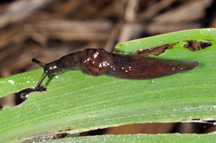Conditions ripe for slug activity in Indiana farm fields
April 22, 2014
 |
|
A slug feeds on a corn plant leaf. Cool, wet conditions like Indiana's this spring are prime for slug activity in farm fields with a history of the pest. (Purdue Entomology photo/John Obermeyer) |
WEST LAFAYETTE, Ind. - A wet spring that has delayed fieldwork in Indiana has created conditions ideal for slugs to thrive, a Purdue Extension entomologist says.
Slugs are most common in no-till systems and weedy fields. These mollusks without shells can wreak havoc on corn and soybean seedlings - especially when seed slots aren't properly closed at planting.
One way for farmers to know whether they should expect slug activity this spring is to consider field history.
"Slugs don't fly in," John Obermeyer said. "If you had slugs last year, you'll have slugs this year."
The problem with these pests is that they are nearly impossible to control. Regular insecticides, whether granular, liquid or seed-applied, are ineffective because slugs slime over them.
While some baits can be used in corn, Obermeyer said the expense and difficulty of distribution make them impractical as anything other than a last resort.
Instead, growers should focus on environment disruption by managing weeds and crop residue, especially in avoiding the matting of dead plant material on the ground.
"Tillage is the best option in many cases where we have established slug activity," Obermeyer said. "Row cleaners give the seedlings an advantage to get up and going, which is the best medicine in many cases for slug damage."
Once crops are planted and have emerged, growers can identify slug-feeding damage in corn by the linear scars on leaves. In severe cases, corn leaves might be tattered in a way that resembles hail damage.
In soybeans, slugs feed on the hypocotyl and cotyledons, rather than the foliage.
If feeding is minor, both corn and soybean plants will often outgrow the damage. In severe cases where the plant's growing point is damaged, recovery is highly unlikely. Such damage widespread in a field could warrant replanting.
Writer: Jennifer Stewart, 765-494-6682, jsstewar@purdue.edu
Source: John Obermeyer, 765-494-4563, obe@purdue.edu
Ag Communications: (765) 494-2722;
Keith Robinson, robins89@purdue.edu
Agriculture News Page

